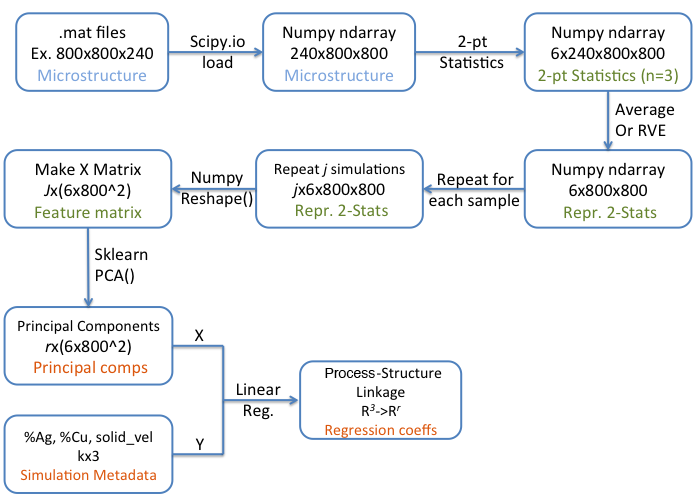Detailed Workflow:
After meeting with Dr. Kalidindi and Yuksel we have clarified what our overall goals are and several methods to get there.
We will continue to attempt to infer a mapping between the input space (3-dimensional real numbers) and the output space (r-dimensional real numbers).
We already have the outputs we will use.
We do not have the principal components yet, but we are close to having found them.
 We want to use a method to infer some mapping from the green axis to the orange axis in the figure above.
We will start with linear regression and then other methods thereafter.
We want to use a method to infer some mapping from the green axis to the orange axis in the figure above.
We will start with linear regression and then other methods thereafter.
Inputs - Y
- % Ag
- % Cu
- Solidification Velocity
Outputs - X
- Principal component scores for the first r largest components.
Assumptions
We have assumed that any runs with different random instatiations of the initial volume fraction will converge to approximately the same values in 2-point statistical space. This assumption is a little bit heavy; however, we have some support for it based on experiments run by Yuksel. At the current time, the risk from this assumption is relatively low.
Challenges and Opportunities
The following diagram shows a detailed workflow, or rather dataflow, of our project.
The arrows represent small discreet techniques, often only a few lines of code per transition.
The diagram goes from the starting .mat data to the final regression coeffs to map our inputs and outputs.
 We have completed up to the PCA step with one major caveat in the “Average or RVE” step on the right.
Almambet will cover this issue in more detail in a separate blog post.
In short we will:
We have completed up to the PCA step with one major caveat in the “Average or RVE” step on the right.
Almambet will cover this issue in more detail in a separate blog post.
In short we will:
- reduce each volume down to a single representative 2-point statistic,
- run PCA over the 2-pt stats all j simulations,
- calculate how many principal components are needed by looking at the fraction of the singular values over the total of singular values
- reduce each micostructure to the smaller PCA-reduced space (as r PCA scores)
- fit a linear estimator from these PCA scores to the initial conditions (e.g. volume fraction and solidification velocity)
- ~Possibly~ see if we can reconstruct an approximation all the way back to a “real micostructure”